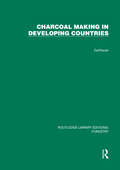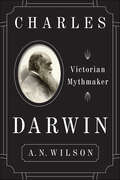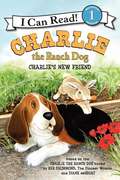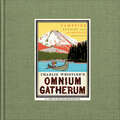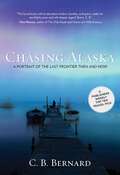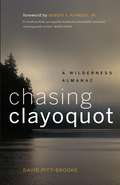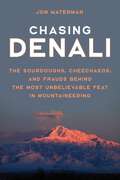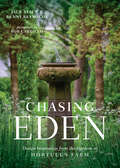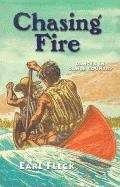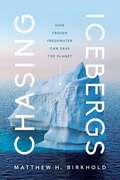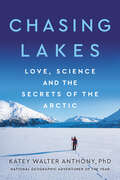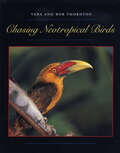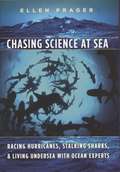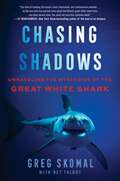- Table View
- List View
Charcoal Making in Developing Countries (Routledge Library Editions: Forestry)
by Gerald FoleyOriginally published in 1986, this book provides a detailed examination of programmes to introduce improved charcoal making techniques throughout the developing world. Charcoal making is widely regarded as an extremely wasteful use of scarce wood resources. The book includes a section on the physics and chemistry of charcoal and descriptions of the various traditional methods of charcoal making. Patterns of charcoal supply and distribution are analysed and efforts to introduce improved charcoal making techniques are described and evaluated.
Charles Darwin: The Concise Story of an Extraordinary Man
by Tim M. BerraA brief biography of English naturalist responsible for the advancement of the science of evolution.Two hundred years after Charles Darwin’s birth (February 12, 1809), this thoroughly illustrated, yet concise biography reveals the great scientist as husband, father, and friend.Tim M. Berra tells the fascinating story of the man and the idea that changed everything. Berra discusses Darwin’s revolutionary scientific work, its impact on modern-day biological science, and the influence of Darwin’s evolutionary theory on Western thought. But Berra digs deeper to reveal Darwin the man by combining anecdotes with carefully selected illustrations and photographs.This small gem of a book includes 20 color plates and 60 black-and-white illustrations, along with an annotated list of Darwin’s publications and a chronology of his life.“Berra meets the essential curiosities a reader new to Darwin will have about a scientist still controversial in some quarters: Berra describes Darwin’s wealthy family background; notes his search for a purpose in life, which led to his embarkation on the survey ship HMS Beagle; chronicles Darwin’s fabled voyage on that ship; steers Darwin into his happy marriage to an heiress to the Wedgwood pottery fortune; and recounts the éclat with which On the Origin of Species burst upon the world in 1859. . . . A finer asset of this volume is its abundance of portraits and illustrations, including a suite of photos taken by Berra of Darwin’s home.” —Booklist
Charles Darwin: Victorian Mythmaker
by A.N. WilsonA radical reappraisal of Charles Darwin from the bestselling author of Victoria: A Life.With the publication of On the Origin of Species, Charles Darwin—hailed as the man who "discovered evolution"—was propelled into the pantheon of great scientific thinkers, alongside Galileo, Copernicus, and Newton. Eminent writer A. N. Wilson challenges this long-held assumption. Contextualizing Darwin and his ideas, he offers a groundbreaking critical look at this revered figure in modern science.In this beautifully written, deeply erudite portrait, Wilson argues that Darwin was not an original scientific thinker, but a ruthless and determined self-promoter who did not credit the many great sages whose ideas he advanced in his book. Furthermore, Wilson contends that religion and Darwinism have much more in common than it would seem, for the acceptance of Darwin's theory involves a pretty significant leap of faith.Armed with an extraordinary breadth of knowledge, Wilson explores how Darwin and his theory were very much a product of their place and time. The "Survival of the Fittest" was really the Survival of Middle Class families like the Darwins—members of a relatively new economic strata who benefited from the rising Industrial Revolution at the expense of the working classes. Following Darwin’s theory, the wretched state of the poor was an outcome of nature, not the greed and neglect of the moneyed classes. In a paradigm-shifting conclusion, Wilson suggests that it remains to be seen, as this class dies out, whether the Darwinian idea will survive, or whether it, like other Victorian fads, will become a footnote in our intellectual history.Brilliant, daring, and ambitious, Charles Darwin explores this legendary man as never before, and challenges us to reconsider our understanding of both Darwin and modern science itself.
Charles Manson was an Environmentalist
by Ralph MaughanIn the fall of 1979, millions of some of the most beautiful acres in the world were under threat. The political heat surrounding the environmental controversy prompted then Senator Frank Church to wear a bullet proof vest to public hearings. This is Ralph Maughan's personal story of the courageous creation of the Frank Church - River of No Return Wilderness.
Charles Taylor’s Ecological Conversations: Politics, Commonalities And The Natural Environment
by Glen LehmanThe author uses the work of the eminent Canadian philosopher, Charles Taylor, to develop a critique of those political perspectives that are based on instrumental ways to reason about the world, claiming that such perspectives invariably sever the connections between the social and natural worlds.
Charles and Emma: The Darwins' Leap of Faith
by Deborah HeiligmanCharles Darwin published The Origin of Species, his revolutionary tract on evolution and the fundamental ideas involved, in 1859. Nearly 150 years later, the theory of evolution continues to create tension between the scientific and religious communities. Challenges about teaching the theory of evolution in schools occur annually all over the country. This same debate raged within Darwin himself, and played an important part in his marriage: his wife, Emma, was quite religious, and her faith gave Charles a lot to think about as he worked on a theory that continues to spark intense debates.Deborah Heiligman's new biography of Charles Darwin is a thought-provoking account of the man behind evolutionary theory: how his personal life affected his work and vice versa. The end result is an engaging exploration of history, science, and religion for young readers. Charles and Emma is a 2009 National Book Award Finalist for Young People's Literature.
Charleston: Race, Water, and the Coming Storm
by Susan CrawfordAn unflinching look at a beautiful, endangered, tourist-pummeled, and history-filled American city.At least thirteen million Americans will have to move away from American coasts in the coming decades, as rising sea levels and increasingly severe storms put lives at risk and cause billions of dollars in damages. In Charleston, South Carolina, denial, boosterism, widespread development, and public complacency about racial issues compound; the city, like our country, has no plan to protect its most vulnerable. In these pages, Susan Crawford tells the story of a city that has played a central role in America's painful racial history for centuries and now, as the waters rise, stands at the intersection of climate and race. Unbeknownst to the seven million mostly white tourists who visit the charming streets of the lower peninsula each year, the Holy City is in a deeply precarious position. Weaving science, narrative history, and the family stories of Black Charlestonians, Charleston chronicles the tumultuous recent past in the life of the city—from protests to hurricanes—while revealing the escalating risk in its future. A bellwether for other towns and cities, Charleston is emblematic of vast portions of the American coast, with a future of inundation juxtaposed against little planning to ensure a thriving future for all residents. In Charleston, we meet Rev. Joseph Darby, a well-regarded Black minister with a powerful voice across the city and region who has an acute sense of the city's shortcomings when it comes to matters of race and water. We also hear from Michelle Mapp, one of the city's most promising Black leaders, and Quinetha Frasier, a charismatic young Black entrepreneur with Gullah-Geechee roots who fears her people&’s displacement. And there is Jacob Lindsey, a young white city planner charged with running the city&’s ten-year &“comprehensive plan&” efforts who ends up working for a private developer. These and others give voice to the extraordinary risks the city is facing. The city of Charleston, with its explosive gentrification over the last thirty years, crystallizes a human tendency to value development above all else. At the same time, Charleston stands for our need to change our ways—and the need to build higher, drier, more densely-connected places where all citizens can live safely. Illuminating and vividly rendered, Charleston is a clarion call and filled with characters who will stay in the reader&’s mind long after the final page.
Charley Waterman's Tales of Fly-Fishing, Wingshooting, and the Great Outdoors
by Charley WatermanCharley Waterman was a true Renaissance sportsman. He kept his interests broad, his knowledge deep yet playful. This book is no exception.This collection of stories from his long and varied life in the great outdoors featuresflyfishing on western creeks, on such storied trout streams as the Letort, and on the Florida flats; chasing sage grouse in Montana, ptarmigan in Alaska, and quail in Mexico, all behind his beloved bird dogs; and Waterman's philosophical scrutinies of tradition and the mysticism behind shotgunning, rounded out with tales of runaway boat trailers and camping in the Everglades. Written in Waterman's usual humor and understatement, this volume is the crowning achievement of his writing career.
Charlie The Ranch Dog: Charlie's New Friend (I Can Read! #Level 1)
by Ree DrummondCharlie the Ranch Dog is the protector of Mama's garden. No wily rabbit is going to stop Charlie!
Charlie Whistler's Omnium Gatherum: Campfire Stories and Adirondack Adventures
by Philip Delves BroughtonIn the tradition of The Dangerous Book for Boys, a visually dazzling compendium of practical knowledge, fascinating trivia, and worldly wisdom for young boys—designed as a charming and informal full-color family scrapbook treasured by generations of one family at their Adirondack summer camp.On a late summer afternoon, while rustling around in his family’s Adirondack cabin, a boy named Charlie Whistler finds a dusty cloth-bound scrapbook. It is the Omnium Gatherum, a colorful, illustrated grab bag of stories, arcana, and much more, faithfully collected over generations by Charlie’s father, grandfather, and generations of Whistlers before them.Its pages hold a universe of age-old wisdom, from the simple—how to tie a slipknot—to the esoteric—how to find your way in the forest, or predict the tides—to the exotic—how to understand simple phrases in dozens of languages.Charlie Whistler’s Omnium Gatherum is a delightful, ceaselessly readable, and unique gift book for boys of all ages: a nostalgic evocation of American childhood, a keepsake for modern fathers to hand down to their sons, and an irresistible, page-turning read for everyone who loves to lose themselves in the world of imagination.
Charting Environmental Law Futures in the Anthropocene
by Michelle LimThis book explores a range of plausible futures for environmental law in the new era of the Earth’s history: the Anthropocene. The book discusses multiple contemporary and future challenges facing the planet and humanity. It examines the relationship between environmental law and the Anthropocene at governance scales from the global to the local. The breadth of issues and jurisdictions covered by the book, its forward-looking nature, and the unique generational perspective of the contributing authors means that this publication appeals to a wide audience from specialist academics and policy-makers to a broader lay readership.
Chase the Wind
by Matt SimsThree people are out camping over the weekend to chase a storm and record its statistics. What happens when their anticipations and calculations of the storm's trajectory go wrong?
Chasing Alaska: A Portrait of the Last Frontier Then and Now
by C. B. BernardAlaska looms as a mythical, savage place, part nature preserve, part theme park, too vast to understand fully. Which is why C. B. Bernard lashed his canoe to his truck and traded the comforts of the Lower 48 for a remote island and a career as a reporter. He soon learned that a distant relation had made the same trek northwest a century earlier. Captain Joe Bernard spent decades in Alaska, amassing the largest single collection of Native artifacts ever gathered, giving his name to landmarks and even a now-extinct species of wolf. C. B. chased the legacy of this explorer and hunter up the family tree, tracking his correspondence, locating artifacts donated to museums, and finding his journals at the University of Alaska at Fairbanks. Using these journals as guides, he threw himself into the state once known as Seward&’s Folly, boating to remote islands, hiking distant forests, hunting and fishing the pristine environment, forming a landscape view of the place that had lured him and &“Uncle Joe,&” both men anchored beneath the Northern Lights in freezing, far-flung waters, separated only by time. Here, in crisp, crystalline prose, is his moving portrait of the Last Frontier, then and now.
Chasing Bears: A Canoe Country Adventure
by Earl FleckA rite-of-passage adventure set in the lakes country bordering northern Minnesota and Canada for a father and his two teenage sons.
Chasing Clayoquot
by Robert F. Kennedy Jr. David Pitt-BrookeFirst published in 2004, and now with a new introduction by the author and a foreword by Robert F. Kennedy Jr., this book of natural history, environmentalism, and politics explores one of the Earth's last primeval places: Clayoquot Sound. Pitt-Brooke takes the reader on 12 journeys, one for each month of the year. Each journey covers the outstanding natural event of that season, such as whale-watching in April, shorebird migration in May, and the salmon spawn in October.
Chasing Denali: The Sourdoughs, Cheechakos, and Frauds behind the Most Unbelievable Feat in Mountaineering
by Jonathan WatermanThe history of mountaineering began on Denali with the legendary story of four gold miners (called &“Sourdoughs&” because they carried sourdough starter with them at all times) who claimed to have summited after climbing more than 8,000 feet of steep snow and ice, then back down again—all in a single and incredibly dangerous day in 1910. Lugging a 25-pound, 14-foot flagpole to mark their success, they took on North America&’s highest peak using sheet metal crampons, coal shovels, hatchets, and alpenstocks to balance their way up the mountain. Was the expedition a success or a hoax? Denali climber Jon Waterman brings this colorful mountaineering mystery to life.
Chasing Eden: Design Inspiration from the Gardens at Hortulus Farm
by Jack Staub Renny Reynolds&“Vision, tenacity, and a perfectionist&’s eye are the qualities that shine out from this account of a paradise garden created by two of America&’s foremost stylists.&” —Anna Pavord, author of The Curious Gardener and Landskipping One of the most spectacular private gardens in America, Hortulus Farm is the masterpiece of Renny Reynolds and Jack Staub, renowned experts in the fields of design, gardening, and entertaining. It is beautifully captured in Chasing Eden, a lavishly illustrated roadmap to creating a personal Eden. Hortulus Farm is a not only a model of classical tenets, but also a showcase of how traditions can be successfully broken. Gardeners will discover information on specific design principles, from vistas and allées to hardscaping and water features. They will also learn how to adapt these principles to less-than-optimal settings without sacrificing a site&’s sense of place. Both aspirational and practical, Chasing Eden will inspire home gardeners to create their own earthly paradise.
Chasing Fire: Danger in Canoe Country
by Earl Fleck'Fire Danger High' reads the sign at the US Forest Service ranger station as thirteen-year-old Danny Forester returns to the Boundary Waters Canoe Area Wilderness for another family canoe trip adventure. He is a year older, taller, and more skilled. Still, the unpredictable events of the trail test his courage and endurance. Early on, he helps his family rescue another family, the Tuckers from Ohio, who have swamped on huge windswept Lake Lac La Coix. Then, on a risky night paddle, the Foresters leave the Tuckers, including thirteen-year-old Julie Tucker, to a Canadian ranger station for emergency medical evaluation. Despite the exhausting rescue and increasing fire danger, Danny and his family are still able to follow their planned route through canoe country. They discover an enormous beaver dam and lodge, spot a bull moose feeding, sight a bald eagle, and hear loons singing through the night. Danny's younger sister, Rachel, photographs nature, tape-records birdsongs and teases her brother about the attention he has paid to Julie Tucker. Danny's older brother, Mike, is off fighting forest fires, protecting the BWCAW, when he meets up with his family. Danny tests his skill and courage by camping out "solo" on Bear Island on the last night of the trip. In the dramatic conclusion, Danny draws upon great reserves of inner strength to face the danger of a raging forest fire and save his family. Chapter illustrations by the author convey the essence of this exciting story. Earl Fleck has camped for over thirty years in the BWCAW and Quetico wilderness regions. A psychologist in private practice and an investigator for the Minnesota State Attorney General's Office, he lives with his family near Minneapolis, Minnesota. Also Available by Earl Fleck 'Chasing Bears: A Canoe Country Adventure' TP $12. 95, 0-930100-90-5 - CUSA
Chasing Fog: Finding Enchantment in a Cloud
by Laura PashbyAt first, I didn&’t find fog – fog found me. Liminal, transformative and increasingly elusive – far from a simple cloud of water droplets, fog is a state of mind. As mist drifted through a copse of trees, turning a familiar place strange and otherworldly, Laura Pashby snapped a photograph and an obsession began. Pashby hunts for fog, walks and swims in it, explores its often pivotal role in literature, mythology and history, as well as its environmental significance. There has been a 50 per cent drop in 'fog events' in the past fifty years, fog is drifting away without us noticing and the ecological impact could be calamitous. As she journeys to the foggiest places she can find, Pashby immerses herself in Dartmoor&’s dangerous fog, searches for the Scottish haar, experiences Venice&’s magical mist, tell us the myths behind the River Severn&’s fog and the shipwrecks it hides. It&’s easy to get lost in fog, but sometimes it&’s where imperceptible things can be found, including in ourselves. Chasing Fog is a captivating meditation on fog and mist, a love song to weather and nature&’s power to transform.
Chasing Icebergs: How Frozen Freshwater Can Save the Planet
by Matthew H. BirkholdA deeply intelligent and engrossing narrative that will transform our relationship with water and how we view climate change.The global water crisis is upon us. 1 in 3 people do not have access to safe drinking water; nearly 1 million people die each year as a result. Even in places with adequate freshwater, pollution and poor infrastructure have left residents without basic water security. Luckily, there is a solution to this crisis where we least expect it. Icebergs—frozen mountains of freshwater—are more than a symbol of climate change. In his spellbinding Chasing Icebergs, Matthew Birkhold argues the glistening leviathans of the ocean may very well hold the key to saving the planet. Harvesting icebergs for drinking water is not a new idea. But for the first time in human history, doing so on a massive global scale is both increasingly feasible and necessary for our survival. Chasing Icebergs delivers a kaleidoscopic history of humans&’ relationship with icebergs, and offers an urgent assessment of the technological, cultural, and legal obstacles we must overcome to harness this freshwater resource. Birkhold takes readers around the globe, introducing them to a colorful cast of characters with wildly different ideas about how (and if) humans should use icebergs. Sturdy bureaucrats committed to avoiding another Titanic square off against &“iceberg cowboys&” who wrangle the frozen beasts for profit. Entrepreneurs selling luxury iceberg water for an eye-popping price clash with fearless humanitarians trying to tow icebergs across the globe to eradicate water shortages. Along the way, we meet some of the world&’s most renowned scientists to determine how industrial-scale iceberg harvesting could affect the oceans and the poles. And we see firsthand the looming conflict between Indigenous peoples like the Greenlandic Inuit with claims to icebergs and the private corporations that stand to reap massive profits. As Birkhold shepherds readers from Connecticut to South Africa, from Newfoundland to Norway, to Greenland and beyond, he unfurls a visionary argument for cooperation over conflict. It&’s not too late for icebergs to save humanity. But we must act fast to form a coalition of scientists, visionaries, engineers, lawyers and diplomats to ensure that the &“Cold Rush&” doesn&’t become a free-for-all.
Chasing Lakes: Love, Science, and the Secrets of the Arctic
by Katey Walter AnthonyAn aquatic ecologist and permafrost scientist recalls her captivating adventures across the Arctic studying climate change, her quest to find belonging and family, and her journey of faith in a world of science in this poignant, eye-opening, and hopeful memoir in the spirit of Lab Girl, Educated, and Finding the Mother Tree.Katey Walter Anthony’s enchantment with lakes began when she was growing up amid the Sierra Nevada mountains. Today, her love for these bodies of water have taken her to the deepest reaches of Alaska and Siberia, where she is undertaking pioneering research on methane emissions. Chasing Lakes is her story: one-part adventure—complete with shipwrecks and treacherous treks through Arctic storms by helicopter, snowmobile, and foot to measure greenhouse gases—part coming-of-age tale, as she searches for belonging in the wake of a broken childhood, and part spiritual quest to find a wholeness science cannot fill.Somewhere between the remote, frozen landscapes of Siberia and her rough cabin in Alaska, she discovers her spiritual and emotional home when she meets Peter, a bright and humble Minnesota farmer who reinvigorates her faith and helps ground her. Yet finding love and fulfillment brings its own challenges. The closer she gets to having the family she’s always wanted, the further she’s pushed from the important field work that is her passion.Chasing Lakes is a chronicle of a woman seeking truth, adventure, scientific discovery, family, love, and grace. Both an eye-opening look from the frontlines of the climate crisis and an intimate portrait of a brilliant scientist, Chasing Lakes is memoir writing at its finest: beautiful, complex, revelatory, and moving.
Chasing Neotropical Birds (Corrie Herring Hooks Series)
by Vera Thornton Bob Thornton&“This book is for anyone who loves nature photography or birding . . . A fine introduction to the beauty and diversity of this region.&” —Southeastern Naturalist From Belize to Brazil, the forests of the American neotropics are home to an astonishing array of birds—over 3,700 different species, or nearly forty percent of all the birds on earth. Birding enthusiasts Vera and Bob Thornton have spent fifteen years photographing these special and exotic birds in the rainforests of eleven different countries of Central and South America. In this book, you&’ll find more than a hundred spectacular color photographs they took during their travels, along with a highly entertaining account of their adventures—and misadventures—in chasing these exotic neotropicals. The birds pictured here are among the Thorntons&’ personal favorites—birds that, in their words, &“either dazzled us with their beauty, or charmed us by their behavior, or, in a few cases, simply challenged us by the mystique of their rarity.&” This latter category includes such elusive and sought-after birds as the Black-crowned Antpitta, the Zigzag Heron, the Rufous-vented Ground-Cuckoo, the Bare-necked Umbrellabird, and the monkey-eating Harpy Eagle. In the accompanying text, Bob Thornton engagingly describes the challenges as well as the magic of negotiating the neotropical rainforests in search of colorful birds to photograph. For those who would like to follow in the Thorntons&’ footsteps, there are also helpful tips about photographic gear and techniques, preferred places to see the birds, lodging, and guides. For everyone who enjoys excellent nature photography, Chasing Neotropical Birds is a must-have volume.
Chasing Plants: Journeys with a Botanist through Rainforests, Swamps, and Mountains
by Chris ThorogoodA New Scientist Best Book of the Year From an acclaimed botanist and artist, a thrilling and beautifully illustrated expedition around the globe in search of the world’s most extraordinary plants. After making a strange discovery on a childhood trip to Ikea—a stand of sap-sucking, leafless broomrapes, stealing nutrients from their neighbors’ roots—Chris Thorogood dreamed of becoming a botanist and would stop at nothing to feed his growing addiction to plants. In his hair-raising adventures across Europe, Africa, the Middle East, and Asia, Thorogood treads a death-defying path over cliffs, up erupting volcanoes, through typhoons, and out into the very heart of the world’s vast, green wilderness. Along the way, he encounters pitcher plants, irises, and orchids more heart-piercingly beautiful than could ever be imagined. But with Thorogood as our guide in Chasing Plants, we not only imagine: we see. An internationally acclaimed botanical illustrator, Thorogood conjures his adventures spent seed-collecting and conserving plants around the world back to life in his electric paintings, which feature throughout the book. They bring plants out of the shadows, challenging us to see their intrigue and their character, and helping us to understand why plant species must be protected. To join Thorogood in his wild adventures is to be cast under his green spell: readers will never think of plants the same way again.
Chasing Science at Sea: Racing Hurricanes, Stalking Sharks, and Living Undersea with Ocean Experts
by Ellen PragerTo the average office-dweller, marine scientists seem to have the good life: cruising at sea for weeks at a time, swimming in warm coastal waters, living in tropical paradises. But ocean scientists who go to sea will tell you that it is no vacation. Creature comforts are few and the obstacles seemingly insurmountable, yet an abundance of wonder and discovery still awaits those who take to the ocean. With passion and wit, well-known marine scientist Ellen Prager shares her stories as well as those of her colleagues, revealing that in the field ingenuity and a good sense of humor are as essential as water, sunblock, and a GPS. Serendipity is invaluable, and while collecting data is the goal, sometimes just getting back to shore means success. But despite the physical hardship and emotional duress that come with the work, optimism and adventure prompt a particularly hardy species of scientist to return again and again to the sea. Filled with firsthand accounts of the challenges and triumphs of dealing with the extreme forces of nature and the unpredictable world of the ocean, "Chasing Science at Sea" is a unique glimpse below the water line at what it is like and why it is important to study, explore, and spend time in one of our planet's most fascinating and foreign environments.
Chasing Shadows: My Life Tracking the Great White Shark
by Greg Skomal Ret Talbot“At last: the story of tracking the ocean’s most charismatic and controversial predator, compellingly told by the man who has learned more about the Atlantic great white shark than any other person alive. You must not miss this fantastic book!” —Sy Montgomery, New York Times bestselling author of The Soul of an OctopusDr. Greg Skomal, one of the leading great white shark experts in the country, reveals the true nature of these mysterious apex predators, as well as the fascinating story behind their history and startling resurgence With its quaint villages, local restaurants serving up lobster rolls, and miles and miles of warm, sandy beaches, Cape Cod, Massachusetts, is famous for being America’s carefree seaside getaway. But in August 2012, the first confirmed white shark attack in almost eighty years occurred in the region. As shark sightings quickly began to increase on Cape Cod and elsewhere, and large beachside billboards warning about the growing shark population became a common sight, a boogie boarder died after being attacked by a great white shark in Cape Cod’s shallow waters. What had changed to cause news of human-shark interactions to go from being a rarity to being the new normal? As some citizens called for shark culls, nets, drone surveillance, and other extreme solutions, interactions between local residents and scientists, politicians, and those responsible for public safety became tense and frantic. Dr. Greg Skomal, a shark biologist whose lifelong passion has been to gain a more refined understanding of great white sharks, was at the center of it all. This is the story of the great white shark’s return to the eastern seaboard, told through the life of the scientist who found himself in the oftentimes thankless position of having to balance conservation efforts and the drive to do important science with panic and fear in the court of public opinion. Greg has spent decades on a quest to tag, track, and demystify this animal, using every high- and low-tech method at his disposal, including those he invented, and he frequently comes face-to-face with these shadows of the deep. He leaves no stone unturned in his pursuit of the secrets behind the largely unknown lives of these charismatic creatures and in his duty to solve the intricate puzzle of how humans can coexist alongside them. Chasing Shadows is a too-rare conservation success story about restoring an apex predator to an ecosystem that provides a profound, new understanding of a beast so notoriously fierce that it’s nearly impossible to imagine how vulnerable it truly is.
